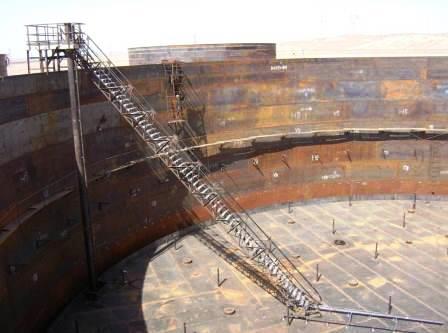The Value of Expert Tank Welding Inspection Services
The Vital Role of Storage Tank Welding Examination in Ensuring Structural Stability and Security Conformity in Industrial Applications
In the realm of commercial applications, tank welding assessment emerges as a critical aspect in guarding architectural stability and ensuring compliance with security regulations. Using a combination of methods such as visual assessments and progressed testing techniques, these assessments serve to recognize and alleviate potential flaws prior to they intensify into significant threats.
Significance of Tank Welding Evaluation

Making certain compliance with industry standards and laws is one more significant facet of container welding assessment. Governing bodies mandate stringent standards for the building and maintenance of storage space containers, and extensive examinations aid companies comply with these demands. Non-compliance can lead to serious penalties, consisting of fines and shutdowns, even more emphasizing the demand for strenuous examination methods.
Additionally, container welding evaluation plays an essential function in maintaining functional efficiency. Regular assessments can recognize possible issues prior to they escalate, helping with prompt repair work and lessening downtime. This positive method not only boosts security yet also adds to set you back financial savings in the future. In summary, the relevance of storage tank welding evaluation depends on its capability to safeguard public health, secure the environment, and guarantee conformity with regulatory structures.
Key Evaluation Strategies
Effective tank welding inspection counts on a range of crucial methods that make certain extensive examination of weld quality and structural integrity. Among the most prevalent techniques are visual assessment, ultrasonic testing, radiographic testing, and magnetic bit screening - Tank Welding Inspection. Each approach uses distinct advantages in assessing various aspects of the weld
Aesthetic examination works as the first line of protection, allowing examiners to determine surface problems, irregularities, or disparities in the weld grain. Ultrasonic testing uses high-frequency audio waves to spot internal imperfections, such as cracks or spaces, providing a comprehensive analysis of weld stability. This technique is particularly reliable in identifying problems that may not be noticeable on the surface.
Radiographic screening utilizes X-rays or gamma rays to produce pictures of the welds, exposing internal suspensions and offering an irreversible record for future reference. This method is extremely efficient for essential applications where the risk of failing need to be minimized.
Last but not least, magnetic bit testing is employed to determine surface and near-surface flaws in ferromagnetic materials. By using electromagnetic fields and fine iron particles, inspectors can pinpoint stoppages that could compromise the structural integrity of the container. With each other, these strategies create a robust structure for ensuring top notch welds in industrial applications.
Conformity With Safety And Security Criteria

Normal evaluations play a pivotal duty in making sure compliance by determining prospective failings or deviations from suggested criteria. Assessors are trained to review weld quality, verify product specs, and evaluate the general architectural honesty of storage tanks. Their knowledge is important click here to read in making certain that welding procedures fulfill the needed security standards.
Additionally, conformity with security standards not just protects workers however likewise safeguards the environment from potential dangers such as leakages or catastrophic failings. Organizations that prioritize safety and security compliance are better positioned to minimize dangers, boost operational efficiency, and foster a society of safety within their labor force. In summary, preserving extensive compliance with safety standards is important for the successful operation of storage tank welding activities in industrial setups.
Advantages of Routine Assessments
Normal assessments are integral to keeping the structural stability and safety of welded storage tanks. These examinations give a systematic approach to identifying prospective problems or weak points in the welds, guaranteeing that any concerns are addressed before they escalate into substantial failings. By performing normal assessments, companies can detect rust, fatigue, and various other types of damage that may compromise container performance.
In addition, consistent examinations contribute to conformity with market policies and requirements. Sticking to these standards not just alleviates legal threats however additionally improves the organization's credibility for security and reliability. Regular evaluations promote an aggressive security society, encouraging employees to recognize and focus on the importance of equipment honesty.

Situation Research Studies and Real-World Applications
Situation research studies and real-world applications show the concrete effect of reliable container welding assessment techniques. Following the execution of extensive welding examination protocols, consisting of visual and ultrasonic testing, the center recognized critical defects in weld seams that could have led to disastrous failings.
In a similar way, a water treatment plant executed a comprehensive assessment program for its storage tank welding procedures - Tank Welding Inspection. By incorporating non-destructive testing methods, the plant was able to discover early signs of corrosion and fatigue in weld joints. This prompt treatment expanded the lifespan of the containers and made certain compliance go to my blog with safety guidelines, therefore securing public health and wellness
These case research studies underscore the relevance of regular and systematic tank welding evaluations. By focusing on these practices, sectors can mitigate risks, enhance architectural honesty, and guarantee compliance with security requirements, ultimately resulting in boosted operational effectiveness and minimized responsibilities.

Final Thought
To conclude, storage tank welding examination is an essential component of maintaining structural integrity and safety in commercial applications. Using different assessment strategies guarantees early detection of potential flaws, therefore avoiding right here disastrous failings. Adherence to safety and security standards better improves operational reliability and conformity with regulative requirements. Ultimately, routine examinations not just protect public health and the environment but likewise add to the longevity and performance of essential properties, underscoring the vital function of this technique in industrial operations.